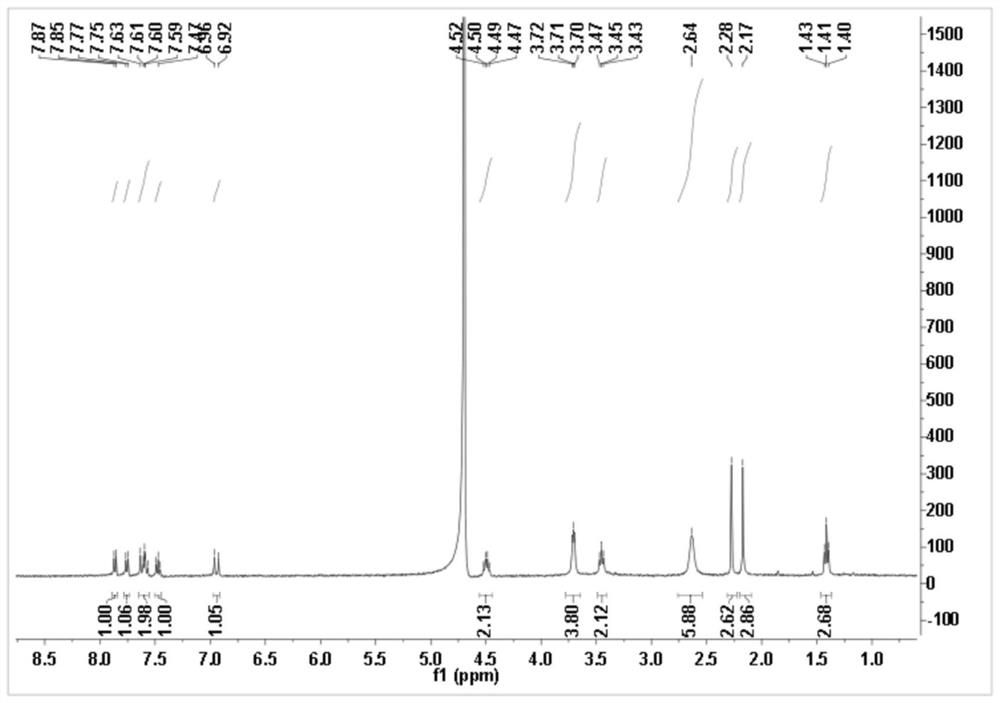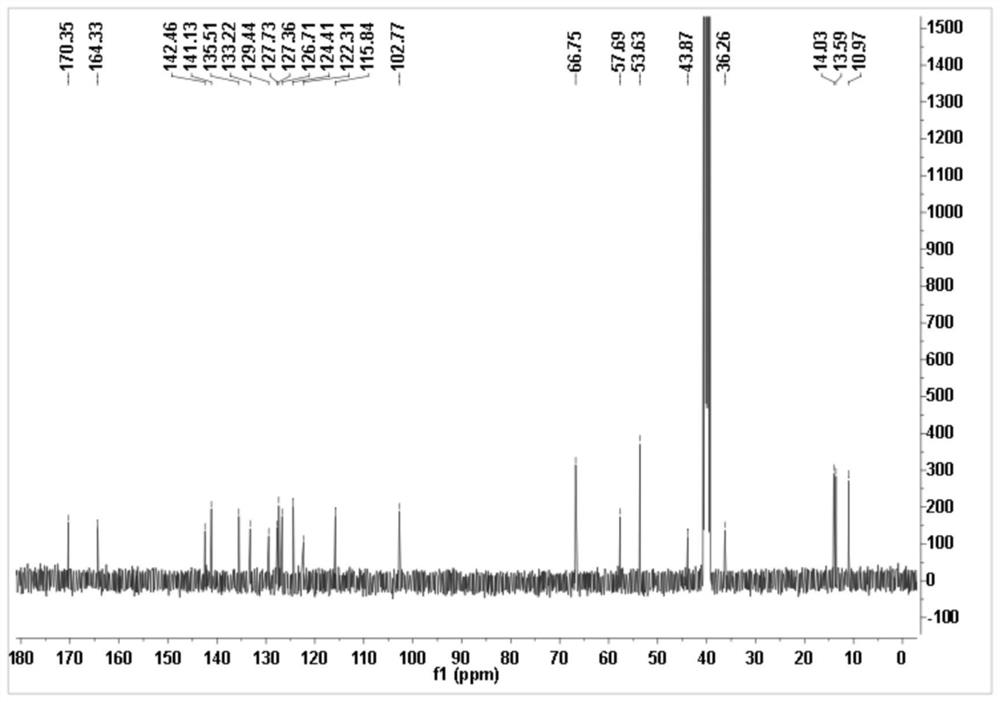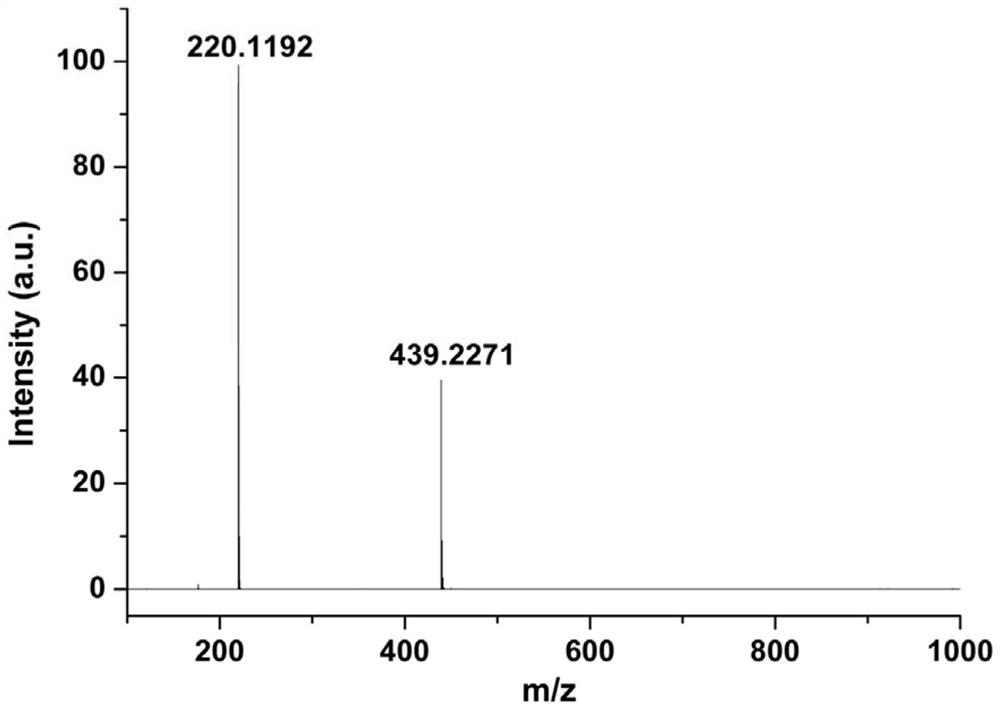A pyrrole-merocyanine derivative fluorescent probe and its preparation method and application
A technology of fluorescent probes and derivatives, applied in fluorescence/phosphorescence, chemical instruments and methods, luminescent materials, etc., can solve the problems of inability to recognize hypochlorite, not many hypochlorite fluorescent probes, and limited practical application, etc. Achieving the effect of wide application value, simple synthesis and post-processing methods, and high fluorescence recognition performance
- Summary
- Abstract
- Description
- Claims
- Application Information
AI Technical Summary
Problems solved by technology
Method used
Image
Examples
Embodiment 1
[0032] The preparation method of the pyrrole-merocyanine derivative fluorescent probe in this embodiment is as follows:
[0033] Dissolve 2.79 g, N-morpholinoethyl-2,4-dimethyl-5-formylpyrrole-3-carboxamide (10 mmol) and 3.05 g of N-ethylbenzothiazole iodide salt (10 mmol) In 0.05L of ethanol, add 0.017 g of piperidine (0.2 mmol) dropwise as a catalyst, reflux and stir at 80°C for 3-4 hours, cool to room temperature, filter under reduced pressure, wash the obtained solid with ethanol, and recrystallize with ethanol The pyrrole-merocyanine derivative fluorescent probe is obtained. The yield of the target product was 82%.
[0034] Adopt nuclear magnetic resonance instrument to carry out nuclear magnetic resonance analysis to the pyrrole-merocyanine derivative that makes, the result is as follows:
[0035] 1 H NMR (400 MHz, D 2O), δ (ppm): 7.85-7.87 (1H, d, Ar-H), 7.75-7.77(1H, d, Ar-H), 7.60-7.63 (d, 1H, CH=), 7.57-7.61 ( 1H, t, Ar-H), 7.45-7.49(1H, t, Ar-H), 6.92-6.96 (1H,...
Embodiment 2
[0038] Determination of Optical Properties of Pyrrole-Merocyanine Derivatives to Hypochlorite
[0039] The pyrrole-merocyanine derivatives prepared in Example 1 above were used as fluorescent probes in citric acid-sodium citrate buffer solution (0.02 mol / L, pH = 4) to prepare a molar concentration of 1×10 -5 mol / L solution, respectively, at a molar concentration of 1×10 -4 mol / L anion (AcO − 、Br − , Cl − , ClO − , ClO 4 − 、CN − , F − 、H 2 PO 4 − 、HPO 4 − , I − 、PO 4 3− , S 2− and SO 3 2− ) or reactive oxygen species (H 2 o 2 , 1 o 2 , OH, NO and O 2 − ) solution, add the same amount of the above-mentioned fluorescent probe solution, and use a UV-visible spectrophotometer or a fluorescence spectrometer to analyze (excitation wavelength is 465 nm), and the obtained UV and fluorescence spectrograms are shown in Figure 4 . pass Figure 4 It can be seen that the pyrrole-merocyanine derivatives prepared by the present invention only have obvious respon...
Embodiment 3
[0042] Detection experiment of pyrrole-merocyanine derivative fluorescent probe in intracellular hypochlorite
[0043] 1 x 10 for HeLa cells -5 The mol / L pyrrole-merocyanine derivative fluorescent probe prepared in Example 1 above and the commercial lysosome localization dye LysoTracker Red were co-incubated at 37°C for 30 minutes to obtain the fluorescence imaging image of HeLa cells, specifically as follows Figure 6 As shown, where: a is the fluorescence imaging image of the green channel; b is the fluorescence imaging image of the red channel; c is the superimposed image of the green channel and the red channel; d is the bright field image; e is the superposition of the green channel, the red channel and the bright field After the picture; f is the overlay map of the intensity distribution of the green channel and the red channel. The green channel fluorescence of the probe in HeLa cells is basically consistent with the LysoTrackerRed red channel fluorescence, with an ov...
PUM
 Login to View More
Login to View More Abstract
Description
Claims
Application Information
 Login to View More
Login to View More - R&D
- Intellectual Property
- Life Sciences
- Materials
- Tech Scout
- Unparalleled Data Quality
- Higher Quality Content
- 60% Fewer Hallucinations
Browse by: Latest US Patents, China's latest patents, Technical Efficacy Thesaurus, Application Domain, Technology Topic, Popular Technical Reports.
© 2025 PatSnap. All rights reserved.Legal|Privacy policy|Modern Slavery Act Transparency Statement|Sitemap|About US| Contact US: help@patsnap.com



